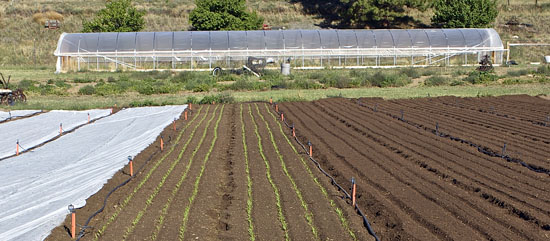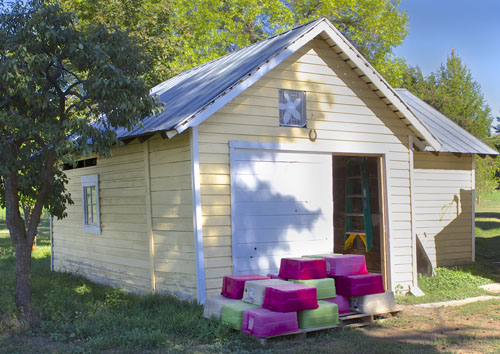home | internet service | web design | business directory | bulletin board | advertise | events calendar | contact | weather | cams

  Typically, Alyssa Jumars is outside working by 6 a.m., but on Tuesdays she has time to linger over a cup of coffee before starting fieldwork. Typically, Alyssa Jumars is outside working by 6 a.m., but on Tuesdays she has time to linger over a cup of coffee before starting fieldwork.PART SIX OF A SERIES Four years into raising gourmet salad greens, Alyssa Jumars says she finally can see a chance of reaching her number one agricultural goal: to grow Plow Horse Produce into a business that generates “a liveable income.” To reach her objective, every week Jumars plants six to eight 100-foot long rows of greens. She picks an average of 200 to 250 pounds of young lettuces, mustards, beet greens and spinach weekly. All the greens are grown, harvested, washed and bagged at Jumars’ 10-acre farm on the Twisp-Carlton Road. Jumars delivers a specialty salad mix to regional restaurants, most of them in the Chelan area, and sells at the Farmer’s Market in Twisp. “It’s been great” and accounts “for about one-quarter of the business I do,” she says of her market sales. Other valley sources of Plow Horse greens are the Glover Street Market, Twisp River Pub, Tappi and Sun Mountain Lodge. Smallwoods also buys Jumars’ greens for its Community Sustainable Agriculture (CSA) program. (CSAs deliver produce to clients who pay a subscription fee at the beginning of the season.) “I’ve been growing lettuce because most of my markets are restaurants and it’s something they need all year,” says Jumars, who is starting to experiment with baby carrots and is considering a sweet potato crop next year. “I try to add something new every year,” she explains, “something you can’t get off the SYSCO [wholesale food distribution] truck.” A few weeks from now, when Mother Nature ends the local growing season, Jumars estimates she will have harvested 4,000 pounds of greens since early May. “I turn a lot back under,” she says. “I try to have more than I need so I can pick the best looking ones.”  Above: lettuces, mustards, spinach and beet greens that are next to be harvested. Above: lettuces, mustards, spinach and beet greens that are next to be harvested. A grant through a federal soil conservation program was used to build the unheated greenhouse. A grant through a federal soil conservation program was used to build the unheated greenhouse.She had about 45 minutes of bad luck this year – an early August storm loaded with hail that knocked out two to three weeks’ worth of crops. But because she sows seed continuously and raises fast-growing plants, she recovered quickly. A boost was receiving a grant from the Natural Resources Conversation Service, a program of the U.S. Department of Agriculture, to put up a greenhouse. That meant she could start planting in March and start harvesting earlier than in 2012, which was her first year farming in the Methow. The unheated greenhouse will be used to plant cold-hardy greens this fall with the expectation of harvesting until Thanksgiving. It also is the likely site for a summer sweet potato crop next year. So how did a 28-year-old native of Seattle with a major in Spanish Literature at Middlebury College in Vermont become a farmer in the Methow Valley? Quite by happenstance, it seems. “I really liked languages,” explains Jumars, who planned to travel and find work in international development post-college. But the summer after graduation changed everything. She stayed in Vermont to work on a local food-growing project. “I loved being outside and just got hooked [on farming],” she says. That experience led to partnering with a college friend to form a CSA and raise dozens of vegetables on about four acres of his family’s 100-acre hay farm in Oregon. The reason she now is specializing in growing “one crop really well” is that she found the pressure of growing about 50 different crops plus the management responsibilities of the CSA were overwhelming for a beginning farmer.  The salad greens are picked and placed into colored plastic tubs, then moved to the cooler in this shed. They then are washed in a large sink and spun dry in two one-time washing machine tubs that act like giant salad spinners before being bagged. The salad greens are picked and placed into colored plastic tubs, then moved to the cooler in this shed. They then are washed in a large sink and spun dry in two one-time washing machine tubs that act like giant salad spinners before being bagged.
Even more daunting, she and her business partner visited a farm that raised vegetables and Belgian draft horses and became “enchanted with the whole idea” of farming with horsepower. “We were young and pretty foolish,” Jumars says of their decision to buy a team of horses. They later wondered why the owners would even sell a team of six-year-old horses that had only worked a farm for one year to such complete novices. “We literally didn’t know enough to know we didn’t know anything,” Jumars told Grist. “We couldn’t keep up their training.” A couple of non-injury horse wrecks later, a frightened Jumars admitted that she needed training and left the Oregon farm for Montana, where she found a mentor who trains both people and horses. “A lot of young people really like the idea of farming with horses,” she says, “but they get the cart before the horse.” “I have learned the hard way that farming with horses isn’t quite so simple or romantic as it may seem to the novice eye,” she once posted on her blog. She now owns a 19-year-old Belgian mare named Ray that she calls “my training wheels horse because she’s a lot more experienced than I am.” She adds that Ray also is “one of those special horses who can work alone.” However, tender lettuces are not crops to cultivate with a horse, so Jumars and Ray work the spring and fall plowing and disking and turn under the cover crops. Six of her 10 acres are fenced for deer and at any given time about 2.5 acres are in production and another 2.5 acres are in replenishing cover crops such as buckwheat, rye and field peas. Everything is on an every-other-year rotation. “All this will get plowed under with the horse before the first snow,” she says, looking across her fallow beds.  Ray, a 19-year-old Belgian mare, is the horsepower behind Plow Horse Produce farm. Here owner Alyssa Jumars drives Ray down the Twisp-Carlton Road so she can cool down after doing spring work. Ray, a 19-year-old Belgian mare, is the horsepower behind Plow Horse Produce farm. Here owner Alyssa Jumars drives Ray down the Twisp-Carlton Road so she can cool down after doing spring work.Asked about the time it takes to farm with Ray, Jumars says, “If conditions are right and the horse is in a cooperative mood,” a single horse can turn an acre of land in “four or five days.” Jumars is blessed with “sandy, fluffy loam” soil. There is a “band of rock” on the upper part of the farm, but what she has under cultivation was in orchard 20 or more years ago. The daughter of two oceanography professors who plan to retire to the Methow Valley on a place they’ve purchased up the road, Jumars says her parents have been “very supportive” and helped her get her farm. While Jumars was growing up the family had a cabin up Eagle Creek outside Leavenworth and Jumars spent the two years before she moved to the Methow on a farm in Leavenworth. That’s where she met her camera-shy fiancée, soon to be husband, Ben Hargrove, who grew up in Cashmere. He calls the farm “her thing,” but Jumars says Hargrove, who works construction, takes care of infrastructure and other farm projects and she “couldn’t do it without him.” Jumars says she is looking forward to the day when Plow Horse Produce is more “organized and manageable so I’m running the farm. But there is so much to do starting out.” A typical week includes harvesting greens Monday, Wednesday and Friday; making deliveries to Chelan on Thursday; working the Saturday farmers’ market and catching up on fieldwork Sunday and Tuesday. “People always think farming is so relaxing,” Jumars says. “I don’t think people understand how fragile food is.” She’s also hoping to get more involved in the local community and perhaps help organize an annual “Eat Local” event that showcases the products of the valleys small farmers. But that’s in the future. For now, Jumars and Hargrove are plotting to escape the farm and the valley this winter for an adventure on his small sailboat. 9/14/2013 Comments
|